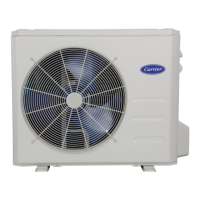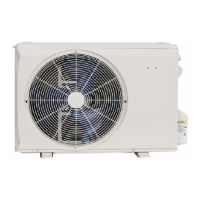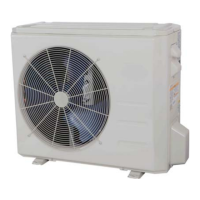Do you have a question about the Carrier 38MHRBC12AA1 and is the answer not in the manual?
Explains hazard identification using signal words like DANGER, WARNING, CAUTION.
Warns of severe personal injury or death from electrical shock.
Warns of explosion risk from air/oxygen mixtures in refrigerant systems.
Guides on proper wiring practices, including wire sizing, types, and connection methods.
Provides the detailed wiring diagram for the 115V cooling-only unit, listing component connections.
Details the wiring diagram for the 230V cooling-only unit, including component connections.
Presents the wiring diagram for cooling-only 18K and 24K sizes, detailing component connections.
Provides the wiring diagram for the 115V heat pump unit, detailing component connections.
Step-by-step instructions for evacuating and charging the system using a vacuum pump.
Explains the deep vacuum method for system evacuation, including required equipment.
Details the triple evacuation method for system evacuation and leak testing.
Details safety precautions for high-voltage electrolytic capacitors and their discharge procedure.
Lists diagnostic codes indicated by LED lights for identifying unit malfunctions.
Provides steps to diagnose and resolve EEPROM parameter errors (E0/F4).
Outlines the diagnosis and solution for communication errors between indoor and outdoor units (E1).
Provides troubleshooting steps for zero crossing detection errors (E2).
Details troubleshooting for indoor fan speed control issues (E3/F5).
Provides troubleshooting for temperature sensor open circuit or short circuit faults (E4/E5/F1/F2/F3).
Details diagnosis and solution for refrigerant leakage detection errors (EC).
Provides troubleshooting steps for overload current protection faults (F0).
Details troubleshooting for IPM malfunction or IGBT over-current protection (P0).
Provides troubleshooting for over/under voltage protection faults (P1).
Details troubleshooting for compressor top high temperature protection (P2).
Outlines troubleshooting for inverter compressor drive errors (P4).
Explains hazard identification using signal words like DANGER, WARNING, CAUTION.
Warns of severe personal injury or death from electrical shock.
Warns of explosion risk from air/oxygen mixtures in refrigerant systems.
Guides on proper wiring practices, including wire sizing, types, and connection methods.
Provides the detailed wiring diagram for the 115V cooling-only unit, listing component connections.
Details the wiring diagram for the 230V cooling-only unit, including component connections.
Presents the wiring diagram for cooling-only 18K and 24K sizes, detailing component connections.
Provides the wiring diagram for the 115V heat pump unit, detailing component connections.
Step-by-step instructions for evacuating and charging the system using a vacuum pump.
Explains the deep vacuum method for system evacuation, including required equipment.
Details the triple evacuation method for system evacuation and leak testing.
Details safety precautions for high-voltage electrolytic capacitors and their discharge procedure.
Lists diagnostic codes indicated by LED lights for identifying unit malfunctions.
Provides steps to diagnose and resolve EEPROM parameter errors (E0/F4).
Outlines the diagnosis and solution for communication errors between indoor and outdoor units (E1).
Provides troubleshooting steps for zero crossing detection errors (E2).
Details troubleshooting for indoor fan speed control issues (E3/F5).
Provides troubleshooting for temperature sensor open circuit or short circuit faults (E4/E5/F1/F2/F3).
Details diagnosis and solution for refrigerant leakage detection errors (EC).
Provides troubleshooting steps for overload current protection faults (F0).
Details troubleshooting for IPM malfunction or IGBT over-current protection (P0).
Provides troubleshooting for over/under voltage protection faults (P1).
Details troubleshooting for compressor top high temperature protection (P2).
Outlines troubleshooting for inverter compressor drive errors (P4).
| Model | 38MHRBC12AA1 |
|---|---|
| Cooling Capacity | 12000 BTU/h |
| Refrigerant | R-410A |
| Voltage | 208/230V |
| Phase | 1 |
| Compressor Type | Rotary |
| Voltage (V) | 208/230V |
| Type | Mini Split |
| EER | 11.0 |












